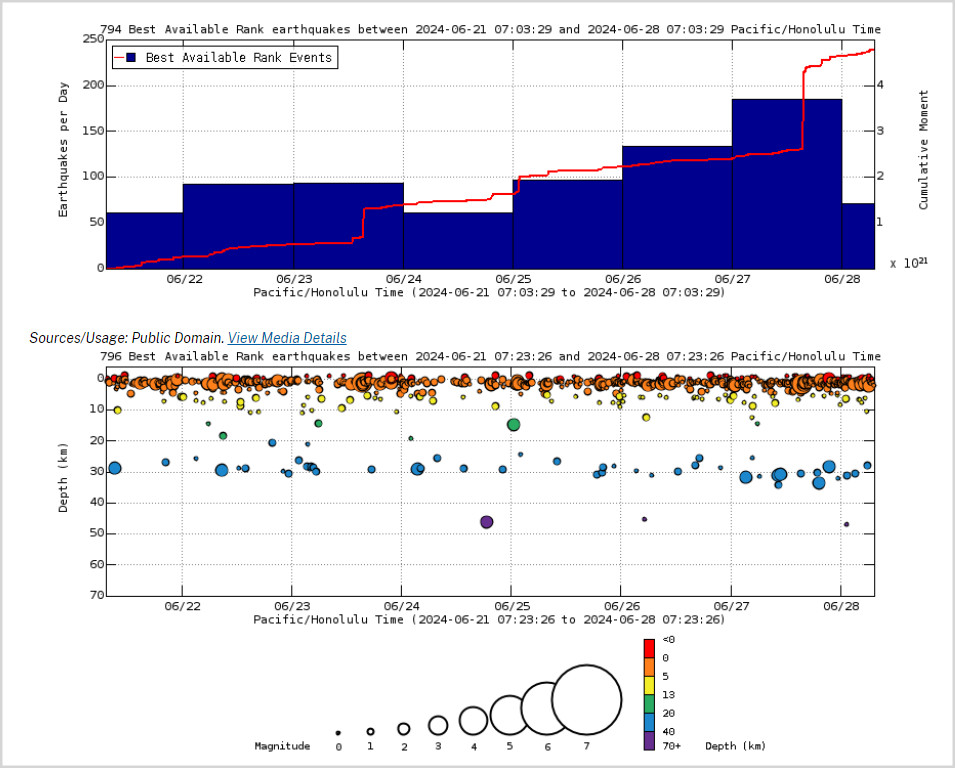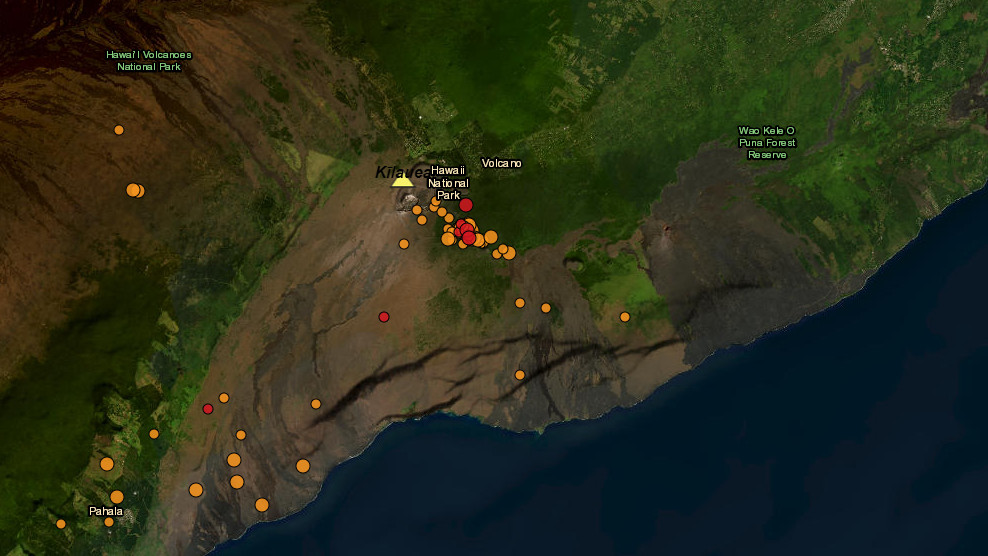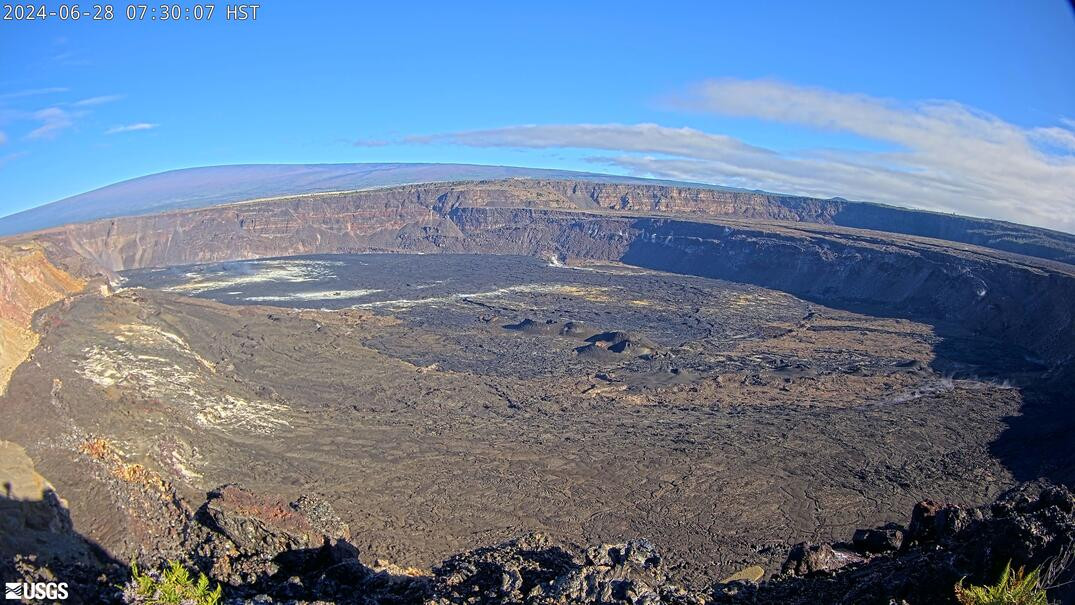(BIVN) – Kīlauea is not erupting and the USGS Volcano Alert Level is at ADVISORY.
Scientists have been reporting moderately elevated behavior at the Hawaiʻi island volcano, with an increase in earthquakes and inflation in the summit and upper rift zones. The activity has persisted since the end of the June 3 eruption on the upper Southwest Rift Zone.
UPDATE – (8:15 a.m.) – In a Friday update, the USGS Hawaiian Volcano Observatory reported that were “nearly 170 earthquakes detected beneath the summit over the past 24 hours, mostly below the south caldera region at depths of 1.5–3 km (1–1.8 mi).”
“Yesterday afternoon, a magnitude-2.9 event at 3:32 p.m. was followed 3 minutes later by a magnitude 3.4 event at 3:35 p.m.,” scientists added, “both occurred in the East Rift connector, southeast of Kaluapele (Kīlauea caldera), and were reported felt by residents of the Volcano community. These events kicked off a swarm of heightened seismic activity that lasted for approximately 90 minutes, but earthquake rates then returned to previous levels and no associated volcanic changes were detected.”
An interactive map on the USGS HVO website shows that as of Friday morning, the highest concentration of earthquakes (large enough to be plotted) are occurring in the upper East Rift Zone.
On Thursday, the USGS HVO website registered the largest number of daily earthquakes in over a week. That number could be surpassed on Friday, if the current uptick in earthquake activity continues.

Above Top: Number of earthquakes per day during the past week (blue bars). The red line is the cumulative moment (energy) release. Bottom: Depth of earthquakes during the past week in the area shown on the map above. Depth is reported relative to sea level, which is equal to a depth of zero on the above plot. On both figures, circle-size represents magnitude, and color indicates depth. (USGS graphs)
As of Friday morning, there were no closures reported within Hawaiʻi Volcanoes National Park due to the moderately elevated behavior. Scientists say increases in seismicity and/or deformation “could result in a new eruptive episode within or near the summit region.”
From the Thursday update provided by the USGS HVO:
Summit and Upper Rift Zone Observations: There were approximately 90 earthquakes detected beneath the summit over the past 24 hours, mostly below the south caldera region at depths of 1.5–3 km (1–1.8 mi). The largest event had a magnitude of 2.3, though most events had magnitudes of 2.0 or less. Rates of ground deformation at the summit remained steady over the past day: tiltmeters at Uēkahuna northwest of the summit and at Sand Hill southwest of the summit respectively recorded approximately 5 and 3 microradians of inflation over the past 24 hours. The most recent measurement of the summit’s SO2 emission rate was approximately 50 tonnes per day on June 10, 2024; accordingly, total SO2 emissions from the summit and recent eruption site are likely less than 200 tonnes per day.
Middle and Lower Rift Zone Observations: Rates of seismicity and ground deformation beneath the middle and lower East Rift Zone and lower Southwest Rift Zone remain low. Recent eruptive activity and ongoing unrest have been restricted to the summit and upper rift zone regions. Measurements from continuous gas monitoring stations downwind of Puʻuʻōʻō in the middle East Rift Zone—the site of 1983–2018 eruptive activity—remain below detection limits for SO2, indicating that SO2 emissions from Puʻuʻōʻō are negligible.
Analysis: Following the June 3 eruption, magma has been repressurizing the storage system beneath Halemaʻumaʻu and the south caldera region, activating earthquakes in the upper East Rift Zone and in the caldera south of Halemaʻumaʻu. At this time, it is not possible to say whether this increase in activity will lead to an intrusion or an eruption in the near future, or simply continue as seismic unrest at depth. Changes in the character and location of unrest can occur quickly, as can the potential for eruption, but there are no signs of an imminent eruption at this time.



by Big Island Video News7:41 am
on at
STORY SUMMARY
HAWAIʻI VOLCANOES NATIONAL PARK - Maps show an increase in the number of earthquakes occurring on the upper East Rift Zone near the summit of Kīlauea.